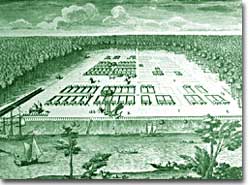5d. Debtors in Georgia

The city of Savannah, once a part of Oglethorpe's utopian design, makes its beginnings in 1734.
The development of Georgia was unlike all the other British colonies. First of all, it was the last to be created. Georgia was founded in 1733, 126 years after Jamestown was successfully planted. England and Europe as a whole were in the midst of an intellectual revolution known as the Enlightenment. Enlightened thinkers championed the causes of liberty and progress. Many believed in the innate goodness of human beings. They asserted that even the worst elements of society might prosper if given the right set of circumstances.
James Oglethorpe was such a thinker. He and a group of charitable investors asked King George for permission to create a utopian experiment for English citizens imprisoned for debt. England's prison population could be decreased, and thousands of individuals could be given a new chance at life. With these lofty goals, Georgia was created.
King George was not terribly concerned with the plight of the English debtor. His advisers pointed out that such a colony in Georgia might provide defense for the South Carolina rice plantations from Spanish Florida. He gave his assent to a charter and Oglethorpe acted.
|
"...And this would turn out very well indeed in that it would encourage very many good families of average means to go to settle there as well as some very good workmen as carpenters, masons, tile makers, blacksmiths, farriers, locksmiths, wheelwrights, coopers, vine growers, shepherds, laborers, and others who would be most useful there. Instead of this, the greatest part of those who have already gone there are nothing but miserable ones both as to their manners and as to their fortunes..." – James Edward Oglethorpe, Original Papers, Feb. 11, 1737 | ||
Here, the settlers would have to conform to Oglethorpe's plan, in which there was no elected assembly. Three major laws governed the colony. The first dealt with the distribution of land. The second and third reflected Enlightened ideals. No slavery was permitted in Georgia, and the possession of alcohol was prohibited. Each debtor was to receive 50 acres of land to farm. This land could not be sold. Silkworms were transported from Europe with the hope of developing a silk industry in Georgia's mulberry trees.
Unfortunately, the plan itself was a miserable failure. Georgia residents complained that some citizens received fertile land while others were forced to work uncooperative soil. Since they could not buy or sell their land, they felt trapped. The mulberry tree plan failed, because the trees in Georgia were the wrong type for cultivating silk. The alcohol ban was openly flouted. Cries to permit slavery followed as the Georgians envied the success of their neighbors. Eventually many simply fled the colony for the Carolinas. King George revoked the charter in 1752 and Georgia became a royal colony. One of the world's best organized utopian experiments came to an abrupt end.






